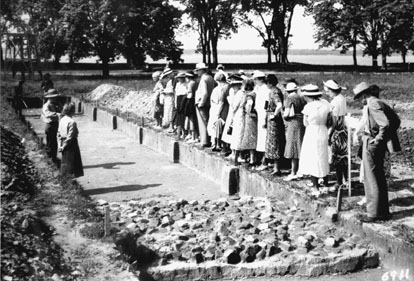

 | Page 625 |  |
was floundering because of conflicts between excavators and architectural historians, Harrington was at first reluctant to be assigned to such a “recent” site, but once he took command in 1936, he started a thirty-year-long building of American historical archaeology.

A 1938 photograph of J. C. Harrington and his wife,Virginia Sutton Harrington, explaining the foundations of Structure 83, Jamestown, to visitors to Virginia’s seventeenth–century colonial capital. Virginia Harrington was the first woman park ranger in the National Park Service, and she was instrumental in opening the Jamestown excavations (1936–1941) to the public.
(Courtesy of the National Park Service, Colonial National Historical Park)
Between 1936 and 1941, as Harrington conducted extensive excavations at Virginia’s first colonial capital (1607–1698), he developed basic field techniques for exploring historic sites with belowground architectural remains. He also started the difficult process of gaining knowledge of historic artifacts and tried to bring the results of the Jamestown project to the public through popular publications. His Field and Laboratory Guide for Recording Archaeological Data (1940) was a starting point for later NPS projects—for instance, it was adopted by Thomas R. Garth in his 1947 excavations at the Whitman Mission (1836–1847) near Walla Walla, Washington.
Work at Jamestown and other sites across North America halted in 1941 with the coming of war, but after World War II Harrington carried out excavations on a number of equally famous sites. Between 1947 and 1950 he skillfully excavated Sir Walter Raleigh’s earthen fort (1585) on the coast of North Carolina, and between 1952 and 1953 he uncovered the small but nationally significant French and Indian War site of Fort Necessity (1754) in western Pennsylvania. His 1957 New Light on Washington’s Fort Necessity was a classic site report that skillfully combined archaeological and documentary sources to fully reconstruct the fort on paper and on the ground. His research on historic artifacts including glass, tiles, and bricks parallels his advances in fieldwork, and in 1954, he published an innovative article on clay pipe chronology that allowed a worldwide dating of seventeenth- and eighteenth-century sites.
Harrington’s pioneer position went far beyond
 |  |